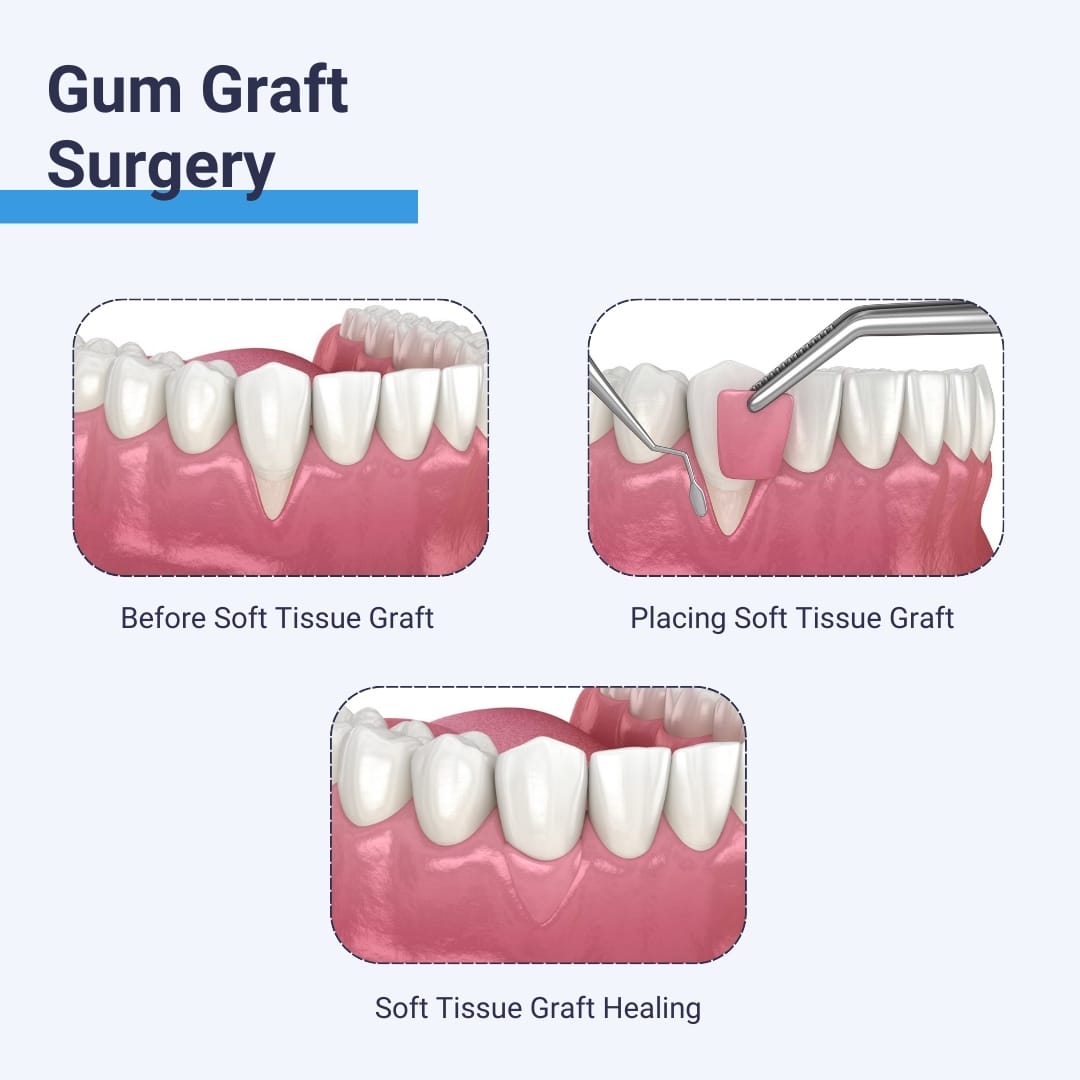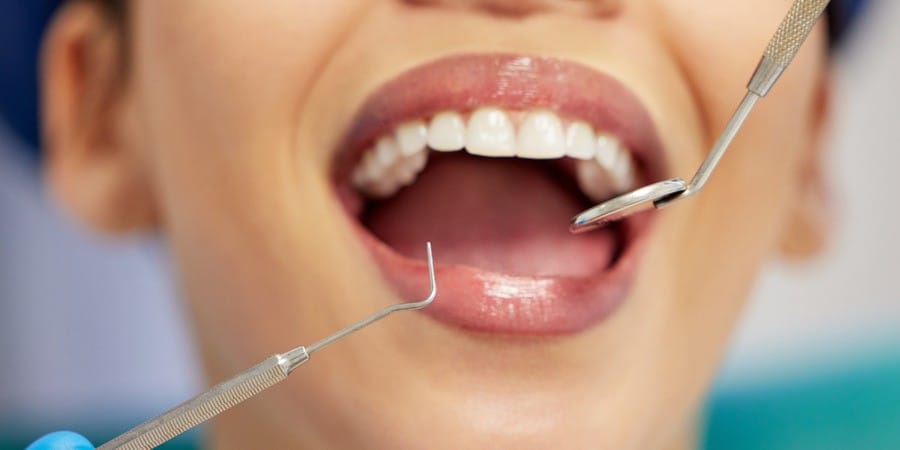What Is a Gum Graft?
A gum grafting procedure replaces missing gum tissue around your teeth, helping to improve oral health. Our periodontist at Clock Tower Dental, Dr. Richard Nejat, can perform gum graft surgery.
When Is Gum Grafting Necessary?
We may recommend gum grafting if you have significant gum recession. When your gums recede, they pull away from your teeth, exposing your tooth roots.
If your tooth roots are exposed, they are more at risk of tooth decay. You are more likely to experience bone loss around your teeth. Your teeth could feel more sensitive to temperature changes or have increased tooth sensitivity whenever you eat anything sweet or sour.
Gum recession is often a side effect of severe gum disease or periodontitis. In this case, we may recommend a gum graft after successful laser treatment for gingivitis or periodontitis.
Gums may also recede if you brush your teeth too vigorously, especially if you use a hard-bristled toothbrush. We only recommend using a soft-bristled toothbrush to clean your teeth using gentle, circular motions.
However, some people have genetically thinner gum tissue. In this case, it can be beneficial to build up the volume of gum tissue, sometimes in preparation for dental implants. Increasing the volume of gum tissue helps prevent any metal from the implants from shining through and can improve aesthetics.
What Are the Different Types of Gum Grafts?
Several types of gum grafts are available. When we examine your gums, we can assess which procedure may suit your specific needs. The possible procedures are outlined below.
Connective Tissue Graft
Most gum grafts are connective tissue grafts and successfully treat exposed tooth roots. Our periodontist will make a small incision in the roof of your mouth and the upper palate to create a flap of skin.
A small amount of tissue is carefully removed from underneath the flap. This tissue is called sub-epithelial connective tissue. Once the tissue is removed, the graft is stitched over the gum, and the flap is stitched shut.
Free Gingival Graft
This graft is similar to a connective tissue graft, again taking tissue from the roof of your mouth. However, the process is slightly different.
Instead of creating a flap and removing tissue from underneath, a small amount of tissue is removed directly from your upper palate. It is then stitched over the gum being treated.
We may recommend this procedure if you have naturally thinner gums and require more tissue to help increase their volume.
Pedicle Graft
A pedicle graft is taken from a nearby gum and is grafted around the tooth requiring additional gum tissue. During this procedure, we create a flap called a pedicle. One edge is still attached to the gum so the tissue can be pulled over the exposed tooth root and stitched into place.
We can only use this type of gum graft if you have plenty of healthy gum tissue near the tooth requiring treatment.
Another option is to use gum grafting material from a tissue bank. We may also choose to use stimulating proteins that help encourage your body to produce more bone and tissue.
The Gum Grafting Procedure: What to Expect If You Need a Gum Graft
The steps for gum grafting surgery are outlined below. Your procedure may vary as it will be tailored to meet your needs.
Numbing Your Gums
We will make you feel comfortable by numbing your gums using local anesthetic. If you feel anxious, please ask us about sedation dentistry. We have various options available for your comfort, and the level of sedation can be adjusted to ensure you feel relaxed during treatment.
Preparing the Surgery Site
The next stage is to prepare the surgical site by making an incision into your gums to create a small flap. At this point, we will also thoroughly clean your teeth roots; laser gum treatment may be used as it can sterilize the areas treated.
Removing the Gum Graft
Once your gum is prepared, we make another small incision into the roof of your mouth and remove tissue for grafting. The site is closed using stitches or a periodontal dressing.
Placing the Gum Graft
Our dentist will carefully position the gum graft over the exposed tooth roots and stitch it into position.
Recovery after Gum Graft Surgery
After your gum graft, recovery should be smooth and uneventful. We will give you lots of information on caring for your mouth during healing before you leave our dental office. We may want you to return to our dental office a week or so later so we can check on your gum graft and ensure it is healing properly.
Everyone heals at different rates, but generally, you can expect your recovery to take 1 to 2 weeks. Most people are well enough to return to work within a day or two.
However, if you have multiple gums treated, recovery may take a bit longer. We can give you a better idea of what to expect based on your procedure.

Below is a brief outline of what to expect during healing.
Day One
Immediately after your procedure, you may have some swelling, minor bleeding, and discomfort. We may have prescribed medications to cope with these side effects and if so, please take them as directed.
Ensure you get plenty of rest and don’t do anything too strenuous. Choose cool, soft foods like pudding, smoothies, or yogurt.
You mustn’t floss or brush around the gum graft as this could damage it. Instead, keep the surgical site clean with antibacterial mouthwash. You will be able to brush and floss your other teeth normally.
Week One
Any bleeding should stop within the first day, but swelling can continue for three or four days. You may develop some bruising, which is perfectly normal. These side effects should disappear within a week.
Continue taking medication as prescribed. You can start eating a greater choice of foods like well-cooked vegetables, eggs, fish, and pasta as your gums heal.
Continue to avoid brushing directly on the surgery site, but you can gently brush your teeth near your gum graft. Please don’t brush or floss around the gum graft until we tell you it is safe to do so.
Week Two
During the second week, any swelling and bruising should fade, and your gum graft will begin to feel more comfortable. At this point, you may feel comfortable decreasing any pain medication.
You can continue to add more solid foods to your diet. Please avoid anything crunchy, hard, or spicy that could become stuck around or irritate your surgery site.
We will tell you when it’s safe to resume your normal brushing and flossing routine.
What Are the Benefits and Risks of Gum Grafting?
Gum grafting can offer several benefits, including:
- Reducing your risk of gum disease and tooth decay
- Decreasing tooth sensitivity
- Improving the appearance of your teeth
Most gum grafting surgeries are very successful, but there are always a few risks involved in any surgical procedure. These can include:
- Excessive bleeding
- Infection
- Gum graft failure
It is rare for a gum graft to fail, but if this happens, you will probably notice the tissue looks white and has begun to pull away from your tooth. The lack of color means it has no blood supply and most likely cannot survive.
If you have any concerns about your gum graft, develop a fever, or notice other signs like pus around the surgery site, please contact us immediately so we can help you. At Clock Tower Dental, our expert periodontics team is here to ensure your recovery is smooth and address any issues that may arise.

